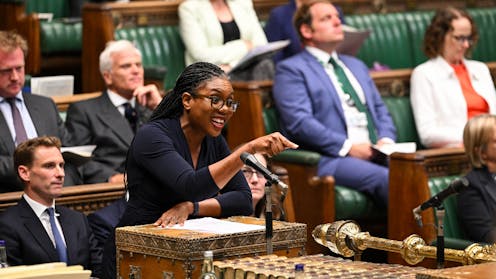What the new grooming gangs inquiry must do to put victims before politics
Kemi Badenoch, Conservative party leader, responds to Home Secretary Yvette Cooper’s statement announcing the new inquiry. House of Commons/Flickr, CC BY-NC-ND
The independent inquiry into child sexual abuse was the largest inquiry in UK history, running from 2015 to 2022 and investigating institutional failures in preventing child sexual abuse. The inquiry’s final report included 20 recommendations for change. So far, zero have been fully implemented.
We both worked on the inquiry and know the pervasive harm of this violence, as well as the consequences it leaves with survivors, families and communities. We are also well aware of the importance of clear language to reflect victims’ experiences and of capturing reliable data.
Louise Casey’s audit of group-based child sexual exploitation and abuse echoes these issues. In particular, it highlights the huge gaps around ethnicity data.
The report addresses decades of failure to protect vulnerable girls from group-based child sexual abuse (“grooming gangs”). The ethnicity of perpetrators and victims has been a flashpoint in the discussion for years.
The national narrative has been that gangs of predominantly Asian men have groomed and exploited young white girls, and that this is why victims’ cases were ignored, dismissed or covered up. Political rows around it have been a factor in the government announcing another inquiry. Over 200 pages, Lady Casey’s audit endeavours to lay out the facts.
Get your news from actual experts, straight to your inbox. Sign up to our daily newsletter to receive all The Conversation UK’s latest coverage of news and research, from politics and business to the arts and sciences.
What does the report say about ethnicity?
Casey’s audit repeatedly emphasises the lack of ethnicity data on a national level. She notes that ethnicity is not recorded for two-thirds of perpetrators, and that the data collected for both victims and perpetrators is “not sufficient to allow any conclusions to be drawn at the national level.”
But she does note: “There is enough evidence available in local police data in three police force areas … which show disproportionate numbers of men from Asian ethnic backgrounds.” And, “There have been enough convictions across the country of groups of men from Asian ethnic backgrounds to have warranted closer examination. Instead of examination, we have seen obfuscation.”
Why might this be? Casey notes that the issue of ethnicity was “shied away from” by local services, due to anxieties about being perceived as racist by endorsing an “Asian grooming gang” narrative.
Her audit points to numerous reviews at different levels, all of which reflect inconsistency in data collection. While some, such as a 2020 Home Office research, found that most offenders of organised exploitation nationwide are white, Casey again notes that the data is not sufficient to conclude this.
When analysing the testimonies of victims of child sexual abuse in other contexts, such as the 2015 inquiry’s Truth Project, often the ethnicity of the perpetrator remains vague. One reason is that whiteness goes unremarked upon in many areas of life in a majority-white country such as the UK. Another serious issue is the poor levels of reporting of child sexual abuse in general in ethnic minority communities. Overall, we lack a good understanding of both victim and perpetrator characteristics.
Want more politics coverage from academic experts? Every week, we bring you informed analysis of developments in government and fact check the claims being made.
Sign up for our weekly politics newsletter, delivered every Friday.
Casey also raises important questions about perpetrator profiles that go beyond their ethnicity, such as what drives them to commit these crimes. We would add another key question – why are young, working class girls from all backgrounds consistently treated as culpable for the crimes committed against them?
If coming from a particular community is a risk factor for perpetration of a certain form of child sexual abuse, more accurate data is needed to say this confidently and in a way that can engage communities rather than alienating them. It is our hope that this new inquiry can do that. In the meantime, Casey has asked for the public to “keep calm” over the data.
House of Commons/Flickr, CC BY-NC-ND
Putting victims over politics
The lack of accurate data has allowed politicians and the far right to take control of the narrative, without strong evidence to back up their claims. Elon Musk’s interventions earlier this year made the implications of this clear.
People can lay claim to “the truth” of child grooming gangs without clear data in support or in opposition. What we can say with conviction – and what Musk was correct in pointing out – was the horrific nature of the crimes perpetrated against victims of sexual violence.
Politicisation of abuse does a serious disservice to victims. As we found through the 2015 inquiry’s extensive work with diverse communities, narratives about the ethnicity of child sexual abuse perpetrators can lead to defensiveness and secrecy among victims from those communities, who fear betraying their own, risking further abuse.
This new inquiry is a much needed opportunity to improve the data. The government has accepted all 12 recommendations, including mandatory collection of ethnicity and nationality data for all suspects in child sexual abuse and criminal exploitation cases.
This is a statutory inquiry, so it has greater powers than past inquiries to compel witnesses to provide evidence. It also means that the inquiry holds some independence from government, hopefully insulating it from some of the politicised rhetoric.
But the current moment still risks loud political voices talking over the expertise of survivors. While it is encouraging to read that survivors’ voices were included in Casey’s investigation, the audit does not say how many nor in what capacity.
We hope that the inquiry takes a lesson from the pioneering approach of the 2015 inquiry. Its victims and survivors consultative panel gave a level of “testimonial justice” to those whose voices are often silenced and ignored.
The new inquiry is a chance to really listen to victims, who have been let down for decades.
Katty Elizarova/Shutterstock
Foremost in everyone’s minds is the need to prevent and deter such abuse from happening in the future. This requires fully understanding the reasons behind inaccurate or incomplete data collection, the motivations of perpetrators and institutional contexts that might facilitate them, and barriers to implementing meaningful responses. This inquiry promises to listen to survivors, without filtering the parts that are uncomfortable to hear.
Amid this, there is another scandal hidden in plain sight. For all the talk about acting on Casey’s findings, there is a huge funding crisis in services that support survivors of child sexual abuse. Our colleagues in the sector report increasing pressure to reduce the amount of care survivors are offered, despite commitments to offer lifelong care for those affected by this deeply damaging crime.
How can we claim to care about prevention when we do not do enough to support those already affected?
The authors do not work for, consult, own shares in or receive funding from any company or organisation that would benefit from this article, and have disclosed no relevant affiliations beyond their academic appointment.




